

Team-based care is based upon six guiding principles that influence the interactions between providers. These principles apply to all providers, with each provider integrating each principle into its day-to-day operations. The six principles are described below.
Seek the best approach to sharing medical information. Some practices might prefer that you send them a fax with a specific cover page to catch their attention, while others might prefer a phone call. Some practices might have an electronic medical record that allows you to securely message them. It is also important to determine who on the team will be communicating with you regarding a patient’s care plan. Some prescribers might want you to contact them directly, while others might want you to contact their nurse or front desk staff.
The care team includes the community pharmacist, pharmacy technician, prescriber, nurse, care manager, etc. Community pharmacist roles may vary based on the specific team needs, patient type, and reimbursement opportunities available.
The impact of team-based care can be measured in a variety of ways, including:
Consider scheduling quarterly or annual meetings to review the measurements and determine a plan to improve outcomes going forward.
Determine resources needed by team members.
Work with other team members to determine the resources needed. For example, primary care practices might need a patient’s adherence to prescribed medications, or they might request home delivery for a patient. Let team members know what you need to conduct patient care (i.e., medication changes, hospital discharge information).
Communicate with patients.
Let patients know that you work with other members of their care team. Encourage the prescriber or care managers to let their patients know you work together to improve their health.
Identify shared goals.
Schedule a face-to-face meeting with a local medical practice to determine shared goals. During this meeting, share your community pharmacy’s goals and identify the services you can offer to help the practice.
Bob is a 67-year-old man who has chronic obstructive pulmonary disease (COPD). He has been in the hospital for a COPD exacerbation and is being discharged today. This is his third hospitalization in two months.
The discussion that follows illustrates how his healthcare team works together to provide team-based care and prevent his rehospitalization.

During his hospital stay, Bob was prescribed a new maintenance medication for his COPD. The hospital sends a prescription for the new medication to the community pharmacy. Per an earlier agreement, the hospital also sends a copy of Bob’s discharge summary. Using the information on the discharge summary, the pharmacy performs a medication review to ensure that Bob is on the correct medication. The pharmacy also provides medication education as necessary.

When Bob goes to the pharmacy to pick up his medication, the pharmacist performs a comprehensive medication review (CMR) and discovers that Bob cannot afford his medication. She also finds out that Bob has been using a rescue inhaler multiple times a day instead of his maintenance inhaler. Additionally, Bob reveals that he does not own a car, which makes transportation to the pharmacy and to the doctor challenging.

The community pharmacist refers Bob to a care manager who helps him fill out an application to receive extra help. The care manager will conduct home visits to ensure that Bob has everything he needs. She will also arrange transportation for follow-up appointments with his primary care provider (PCP) and his pulmonologist.

The community pharmacist lets Bob know that she works with his care manager, primary care provider, and specialist to make sure that he receives the best care possible. She sends a message to Bob’s PCP to let him know Bob has been in the hospital for a COPD exacerbation and has started on a new medication. She lets his PCP know she already conducted a CMR, provided medication education for his new medication, reconciled his active medication list, and identified medication-related problems. She sends this list to the PCP’s nurse via electronic health record secure messaging. In previous meetings, it was determined that Bob’s PCP prefers this form of contact when communicating with patients.

The community pharmacist contacts Bob’s pulmonologist and provides a message similar to the one she shared with his PCP. That is, she tells the pulmonologist that she conducted a CMR, provided medication education for his new medication, reconciled Bob’s active medication list, and identified medication-related problems that pertain to the specialist.
When Bob visits his pulmonologist next week, the doctor will inform him that he has received an active medication list from Bob’s community pharmacist. This information will help the pulmonologist spend most of the appointment assessing Bob’s COPD.

Bob’s healthcare team monitors his hospital visits and notices that he has not been readmitted after 30 days. This exciting news suggests that their collaboration is working!